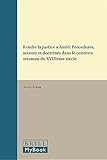Rendre la justice à Amid : procedures, acteurs et doctrines dans le contexte ottoman du XVIIIème siècle / par Yavuz Aykan.
Material type: TextSeries: The Ottoman empire and its heritage ; volume 60Publisher: Leiden ; Boston : Brill, [2016]Description: ix, 274 pages ; 25 cmContent type: text Media type: unmediated Carrier type: volumeISBN: 9789004292109 (hardback : alk. paper)Subject(s): Justice, Administration of -- Turkey -- Diyarbakır -- History -- 18th century | Diyarbakır (Turkey) -- History -- Ottoman Empire, 1288-1918 | Diyarbakır İli (Turkey) -- History -- Ottoman Empire, 1288-1918 | Turkey -- History -- Ottoman Empire, 1288-1918DDC classification: 364.9566/77 LOC classification: KKX283 | .A99 2016Summary: In 'Rendre la justice áa Amid', Yavuz Aykan analyses the legal life of the city of Amid, the capital of Ottoman Diyarbekir province in the 18th century. Making use of court records from the cities of Amid, Harput and Mardin, he explores the centrality of the qadi, the provincial governor, and the provincial mufti to law enforcement. By tracing the genealogies of legal texts used by the mufti for fatwa production, Aykan maps out the broader transformations of various judicial interpretations in their journey from Greater Syria to Transoxiana and the Golden Horde, and finally into Ottoman legal praxis. As such, this book offers a far more historicized approach to the multiple actors and hierarchies of juridical systems operating in this provincial setting--Back cover.
TextSeries: The Ottoman empire and its heritage ; volume 60Publisher: Leiden ; Boston : Brill, [2016]Description: ix, 274 pages ; 25 cmContent type: text Media type: unmediated Carrier type: volumeISBN: 9789004292109 (hardback : alk. paper)Subject(s): Justice, Administration of -- Turkey -- Diyarbakır -- History -- 18th century | Diyarbakır (Turkey) -- History -- Ottoman Empire, 1288-1918 | Diyarbakır İli (Turkey) -- History -- Ottoman Empire, 1288-1918 | Turkey -- History -- Ottoman Empire, 1288-1918DDC classification: 364.9566/77 LOC classification: KKX283 | .A99 2016Summary: In 'Rendre la justice áa Amid', Yavuz Aykan analyses the legal life of the city of Amid, the capital of Ottoman Diyarbekir province in the 18th century. Making use of court records from the cities of Amid, Harput and Mardin, he explores the centrality of the qadi, the provincial governor, and the provincial mufti to law enforcement. By tracing the genealogies of legal texts used by the mufti for fatwa production, Aykan maps out the broader transformations of various judicial interpretations in their journey from Greater Syria to Transoxiana and the Golden Horde, and finally into Ottoman legal praxis. As such, this book offers a far more historicized approach to the multiple actors and hierarchies of juridical systems operating in this provincial setting--Back cover.
| Item type | Current library | Call number | Status | Date due | Barcode |
|---|---|---|---|---|---|
 Books
Books
|
The BIAA David H. French Library Shelf 62 - Reading Room | H2n AYKAN 30702 | Not for loan | BOOKS-000000023604 |
Includes bibliographical references (pages 243-266) and index.
In 'Rendre la justice áa Amid', Yavuz Aykan analyses the legal life of the city of Amid, the capital of Ottoman Diyarbekir province in the 18th century. Making use of court records from the cities of Amid, Harput and Mardin, he explores the centrality of the qadi, the provincial governor, and the provincial mufti to law enforcement. By tracing the genealogies of legal texts used by the mufti for fatwa production, Aykan maps out the broader transformations of various judicial interpretations in their journey from Greater Syria to Transoxiana and the Golden Horde, and finally into Ottoman legal praxis. As such, this book offers a far more historicized approach to the multiple actors and hierarchies of juridical systems operating in this provincial setting--Back cover.
Text in French
